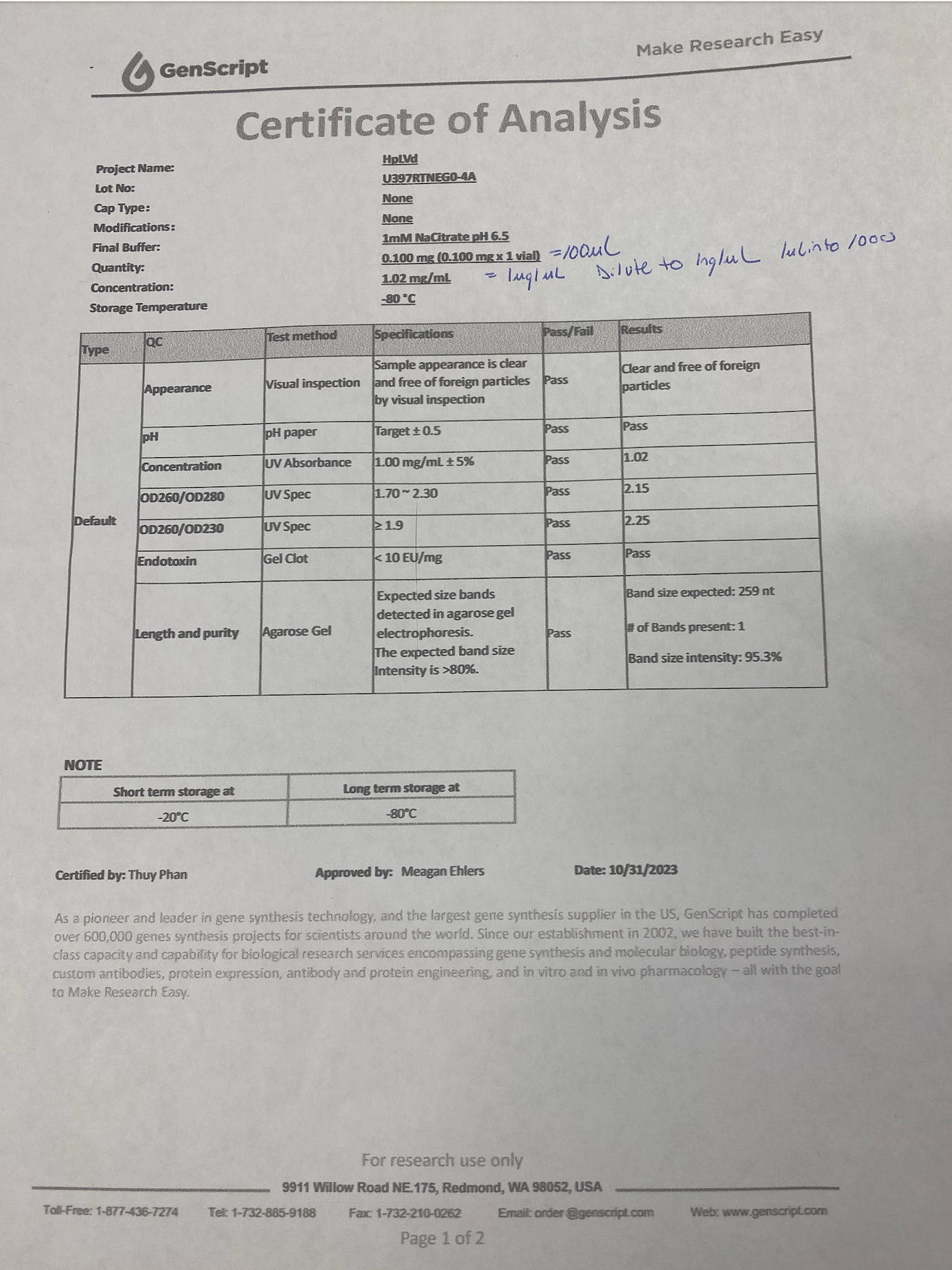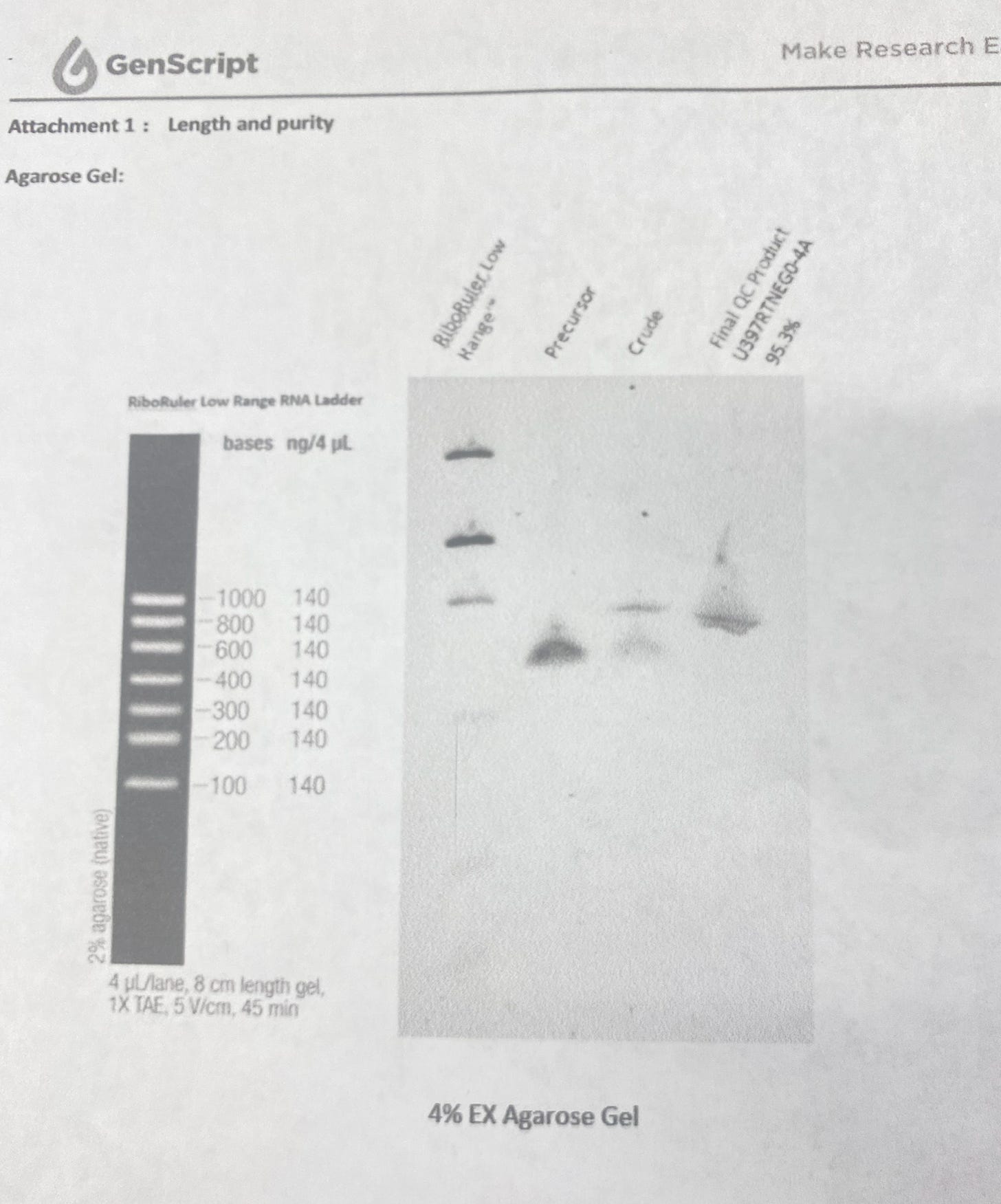Hop Latent Viroid (HpLVd) is 256bp - 260bp circular RNA molecule that is associated with reduced yield and dudding in Cannabis plants. It’s reported to drop yields by 40% and to be a $4B problem in the cannabis industry. It is mechanically transferred with scissors and potentially leaf hoppers.
At Medicinal Genomics we house the largest database in the world that tracks cannabis genomes and its pathogens. One fork of that database is viropedia which tracks the variants in the HpLVd genome across the world.
However, there is a problem with all HpLVd infection studies performed to date. None of them have isolated the viroid, prior to infection. They have all attempted to demonstrate transmission by taking infected leaves, chopping them up in water and rubbing those supernatents onto other plant leaves that have an injury.
They can track HpLVd replication in the newly infected plant but they can’t know for certain that HpLVd is the only transmissible agent that is responsible for the disease. For instance, what if this inoculation process also transferred fusarium or pythium and these are in fact the real disease causing pathogens and the HLVd is just a canary in the coal mine or a viroid that only brings out symptoms in some cannabis genotypes but not others.
This is why Koch’s postulates is so focused on isolation of the virus or viroid as you don’t want to infect a plant with multiple organisms and falsely accuse the wrong pathogen as the disease causing pathogen when it may just be a carrier or symptom modifier.
Being in the testing space for HpLVd, its important we don’t pull a Fauci and spread fear porn to prop up our own testing revenue.
To this end we spent the time to synthesize the 256bp circular RNA genome so it would be free of any other biological contaminant. Over 95% of this RNA is circular and the only contamination is its linear RNA form. Linear RNA is also synthesized in the plant once HLVd starts to replicate.
So this is as isolated as any Koch’s postulates ever performed as we have purely synthesized genomes with zero biological background like you might find in various virus isolation procedures.
Once this RNA was delivered, we immediately ran our HpLVd RT-qPCR curve on it to finally get a real LOD (Limit of Detection). Most vendors of RT-qPCR kits in the cannabis field have fake LODs.
They spike in a DNA template to measure their RT-qPCR LOD and get a very low number (5-10 copies) but this is massive cheat as this LOD doesn’t torture test the efficiency of your RNA→DNA conversion. This is known as the Reverse Transcriptase step or RT step and it is important to measure as this RNA is a circular hairpin and hard to RT.
Thankfully, the MGC test clocks in with great efficiency and a very linear serial dilution across 8 orders of magnitude on real circular RNA templates.
Now we can actually measure an Infective Dose.
We can take the 1ug/ul stock and dilute it 100 fold and 1,000 fold (10ng/ul and 1ng/ul) and inject a known and PURE dose into plants to see if they still get sick.
100ul of 10ng/ul = 1ug total = 7.23 Trillion HLVd circles.
100ul of 1ng/ul = 723 Billion HLVd circles
We are getting close to the number of modRNAs injected in to a person with C19 vaccines (14T -42T).
3 Clones of Jamaican Lion were grow out in separate pots. The two healthiest looking clones were injected with 7.2 Trillion and 723 Billion HpLVd circles.
Now it is time to qPCR track the distribution of this in the plants over time to see if the replication of the viroid kicks into gear. Most folks report 2 weeks for the viroid to start showing up on the roots and 4 weeks it can be detected everywhere.
Most prior inoculations are unlikely to be this concentrated and this pure so we may see more rapid bio-distribution given the high initial dose.
It should be noted that Jamaican Lion in the past, rarely ever spread HpLVd into the leaves. It always retained this in the roots. Even 10 weeks into flowering, Jamaican Lion would be negative in the leaves and petioles, would turn deep purple and would only be positive in very green tissue in the lower canopy.
This recently repeated itself with another cultivar known as UK Cheese.
Collin Palmer was keeping this cultivar alive to study Leaf Hopper HpLVd transmission. It was HpLVd positive in veg. 4 weeks later in flowering and it turned deep purple. It was cold outside so this isn’t the same as the temperature controlled Jamaican Lion experiment.
To our surprise it tested negative after being positive in leaves and roots 4 weeks earlier?
This is where you need to pay attention to raw signals in qPCR. You can see several of the boil preps turn bright purple from the anthocyanins. This could impact qPCR fluorescent detection.
Attenuated qPCR signal is seen for the purple samples.
And elevated baseline fluorescence is seen.
The cure for this is our High Sensitivity Prep that Performs the boil in a magnetic lysis reagent that can be separated and Ethanol washed to eliminate these pigments from the analysis. This magnetic lysis reagent also concentrates the solution so its usually 2-4 CTs more sensitive. We used this in our Leaf Hopper analysis.
When this hyper-sampling is performed with the High Sensitivity Prep, we only see UK Cheese HpLVd signal in the green tissues. The samples after CT 35 are indeterminant. The samples with CTs in the 24 and 26 range are from green stem and petiole.
The next step is to sample this UK Cheese in the roots to see if the same thing occurred in UK Cheese as in Jamaican Lion.. ie HpLVd remains in the roots.
Concurrent to this we will have a Jamaican Lion dose response curve for HpLVd infection to see if this remains in the roots again. Reproduction is the cornerstone of science.
Under normal HpLVd testing paranoia, these plants would have been killed the first time any positive test was delivered. But here we have evidence of at least 2 genotypes of cannabis than can exhibit mosaic tissue expression of HpLVd which varies overtime and can even disappear from the leaves on its own. There is still a lot more to learn about this and these data suggest one take a very different testing strategy with disposable clones than with valuable heirloom mother stocks.
We recommend:
Test your clones with our fast boil prep (Plant Lysis Buffer). This is the quickest time to an answer and we have it fully automated with our MIC/MYRA robotics. We also have it in 10ul reaction format on this platform making it the most affordable clone screening option in the market. Retest these clones. 2 weeks into flowering as some may slip through the cracks due to sampling issues and mosaic expression. This can be done in leaves or roots but the use of dirty roots can cause false negatives with simple boil preps. The High Sensitivity Lysis is better tooled for roots.
Mother plants, sample roots and leaves if you can with the high Sensitivity kit. Since these never go into flowering, you will need the more sensitive assay and multiple sampling points (3 at minimum).
Stay tuned. More testing on Koch’s postulates and UK Cheese should be available shortly.





















Very interesting. I am pretty sure that Hop Latent Viroid (HpLVd) has a biological function in nature that for sure we do not understand, as I believe is the case with all viroids and viruses when they are in equilibrium within the ecosystem. All that nonsense about "obligate parasites" is just absurd. A piece of RNA is an "obligate parasite"? We truly are ridiculous, but anyway...
I find this observation the most important one:
[Under normal HpLVd testing paranoia, these plants would have been killed the first time any positive test was delivered. But here we have evidence of at least 2 genotypes of cannabis than can exhibit mosaic tissue expression of HpLVd which varies overtime and can even disappear from the leaves on its own.]
KMC - Once Upon A Time In The West... half a century ago I'd just pull over and pick me some. If they had left well enough alone, that HLV probably doesn't hop on over (pun intended) to a hybrid that promoted it. Old school WT was robust and pernicious as fuck, they had to control burn it, and even then. Just like C19, this is what happens when talking monkeys try to play god. If it works, don't.... just enjoy it in its natural state. They called it weed, because it is one.